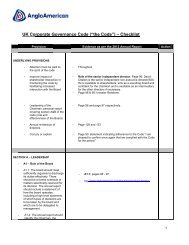Creating Value with the Future in Mind - Anglo American South Africa
Creating Value with the Future in Mind - Anglo American South Africa
Creating Value with the Future in Mind - Anglo American South Africa
You also want an ePaper? Increase the reach of your titles
YUMPU automatically turns print PDFs into web optimized ePapers that Google loves.
manag<strong>in</strong>g our impact on <strong>the</strong> environment Climate change and Energy<br />
Our carbon journey<br />
Outcomes Avoid risk and liability Enable our bus<strong>in</strong>ess to grow<br />
Climate change performance<br />
1–3 YEARS<br />
Cont<strong>in</strong>uous improvement<br />
and asset optimisation<br />
• Carbon and energy<br />
sav<strong>in</strong>gs – aligned to targets<br />
• Climate adaptation –<br />
risks and mitigation plans<br />
• Bus<strong>in</strong>ess unit assessment<br />
of product risks and<br />
opportunities<br />
3–6 YEARS<br />
Pilot<strong>in</strong>g new techniques<br />
and technologies<br />
• Reduced cost of<br />
compliance<br />
• Bus<strong>in</strong>ess unit action on<br />
product risks and<br />
opportunities<br />
• Stakeholder partnerships<br />
on carbon sav<strong>in</strong>gs<br />
6–10 YEARS<br />
Break<strong>in</strong>g new ground<br />
• Carbon offset projects<br />
deliver commercial<br />
benefits<br />
• Adaptation measures<br />
embedded aga<strong>in</strong>st key<br />
climate risks<br />
• New product/market<br />
opportunities are accessed<br />
Build resilience<br />
• Partnerships <strong>with</strong> stakeholders<br />
on carbon reduc<strong>in</strong>g projects<br />
• Embed carbon and energy sav<strong>in</strong>gs<br />
culture <strong>in</strong> <strong>the</strong> workforce<br />
Be proactive<br />
• Carbon trad<strong>in</strong>g used to<br />
m<strong>in</strong>imise cost of compliance<br />
• Climate adaptation measures<br />
designed <strong>in</strong>to bus<strong>in</strong>ess plans<br />
• Low-carbon technology partnership<br />
<strong>with</strong> our key stakeholders<br />
• Carbon offset projects implemented<br />
Be discipl<strong>in</strong>ed<br />
• Energy and carbon performance<br />
management programme<br />
• Regional climate models identify key<br />
site adaptation requirements<br />
• Bus<strong>in</strong>ess units assess product market risks<br />
and opportunities<br />
• Work<strong>in</strong>g <strong>with</strong> government and<br />
<strong>in</strong>dustry for responsible carbon policies<br />
• Evaluate biodiversity carbon offset potential<br />
Individual operations may beg<strong>in</strong><br />
<strong>the</strong>ir journey at different stages,<br />
but each one must eventually<br />
meet all cumulative requirements<br />
of <strong>the</strong> model.<br />
Time<br />
GHG emissions by source <strong>in</strong> 2012<br />
%<br />
Scope 2 GHG emissions from electricty<br />
purchased 53<br />
Scope 1 GHG emissions from fossil fuels 24<br />
Scope 1 GHG emissions from methane 16<br />
Scope 1 GHG emissions from processes 7<br />
Energy consumption<br />
by source <strong>in</strong> 2012<br />
%<br />
legislation, as well as <strong>the</strong> outcome<br />
of <strong>the</strong> federal election <strong>in</strong> September<br />
2013, could pose fur<strong>the</strong>r challenges.<br />
Metallurgical Coal has spent around<br />
$350 million to date on <strong>in</strong>itiatives to<br />
reduce its carbon emissions, such as<br />
on-site gas management operations,<br />
connections to provide waste coal<br />
seam gas to gas power stations, and<br />
ongo<strong>in</strong>g contributions to research<br />
organisations. This has had <strong>the</strong> overall<br />
effect of reduc<strong>in</strong>g <strong>the</strong> bus<strong>in</strong>ess’ carbon<br />
footpr<strong>in</strong>t over <strong>the</strong> past five years by<br />
more than 20 million tonnes of CO 2 e.<br />
Our performance<br />
Our focus on implement<strong>in</strong>g targets and<br />
energy-sav<strong>in</strong>g <strong>in</strong>itiatives is deliver<strong>in</strong>g<br />
results. Already, 223 projects,<br />
account<strong>in</strong>g for energy sav<strong>in</strong>gs of nearly<br />
3.6 million gigajoules (GJ), have been<br />
completed. In 2012 <strong>the</strong>se projects<br />
yielded a $75 million sav<strong>in</strong>g <strong>in</strong> energy<br />
costs. We have also saved 3.3 Mt of<br />
CO 2 e as a result of <strong>the</strong>se projects and<br />
methane management programmes<br />
at Metallurgical Coal <strong>in</strong> Australia.<br />
Reduc<strong>in</strong>g our GHG emissions<br />
Our total GHG emissions (Scope 1<br />
and Scope 2) were 17.9 Mt of<br />
CO 2 e, compared <strong>with</strong> 18.8 Mt <strong>in</strong> 2011.<br />
Our 2012 emissions data no longer<br />
<strong>in</strong>cludes <strong>the</strong> contribution of<br />
spontaneous combustion <strong>in</strong> process<br />
emissions, which was partly<br />
responsible for this reduction. We have<br />
discont<strong>in</strong>ued report<strong>in</strong>g on this as it is<br />
not <strong>in</strong>dustry practice to do so and <strong>the</strong>re<br />
is no agreed scientific methodology;<br />
however, we cont<strong>in</strong>ue to estimate and<br />
report on this <strong>in</strong>ternally.<br />
In Australia, our primary alternative<br />
energy projects are <strong>the</strong> methane-fired<br />
power stations at our Moranbah North<br />
and Capcoal collieries (see case study<br />
on page 63). In <strong>South</strong> <strong>Africa</strong>, we have<br />
had positive results from replac<strong>in</strong>g<br />
conventional boilers <strong>with</strong> heat pumps<br />
<strong>in</strong> <strong>the</strong> m<strong>in</strong>e change-houses at our<br />
Kumba Iron Ore, Plat<strong>in</strong>um and<br />
Thermal Coal bus<strong>in</strong>esses. In 2012,<br />
<strong>the</strong> overall contribution of renewable<br />
energy sources to our electricity<br />
consumption was 29%, mostly driven<br />
by our <strong>South</strong> <strong>American</strong> operations.<br />
Energy consumption<br />
Dur<strong>in</strong>g 2012, we consumed<br />
108.3 million GJ of energy<br />
(2011: 102.1 million GJ). The 6%<br />
year-on-year <strong>in</strong>crease was largely<br />
attributable to significant <strong>in</strong>creases at<br />
our Los Bronces copper m<strong>in</strong>e <strong>in</strong> Chile<br />
and our Barro Alto Nickel operation <strong>in</strong><br />
Brazil – both of which are ramp<strong>in</strong>g up<br />
production. Disrupted production at<br />
operations <strong>in</strong> <strong>South</strong> <strong>Africa</strong> partially<br />
curbed our energy use, along <strong>with</strong><br />
Scope 1 energy consumption:<br />
renewable 2<br />
Scope 1 energy consumption:<br />
non-renewable 50<br />
Scope 2 energy consumption:<br />
non-renewable 32<br />
Scope 2 energy consumption:<br />
nuclear 2<br />
Scope 2 energy consumption:<br />
renewable 14<br />
<strong>the</strong> 223 energy-sav<strong>in</strong>gs projects<br />
implemented <strong>in</strong> 2012. We achieved<br />
sav<strong>in</strong>gs of around $75 million through<br />
our energy-efficiency projects.<br />
Adaptation<br />
In recent years, we have focused<br />
on assess<strong>in</strong>g <strong>the</strong> potential physical<br />
impacts of climate change <strong>in</strong> a number<br />
of potentially high-risk operational<br />
regions and sites, <strong>in</strong>clud<strong>in</strong>g our<br />
M<strong>in</strong>as-Rio iron ore project <strong>in</strong> Brazil<br />
and our Thermal Coal and Plat<strong>in</strong>um<br />
operations <strong>in</strong> <strong>the</strong> Olifants River<br />
catchment <strong>in</strong> <strong>South</strong> <strong>Africa</strong>. Build<strong>in</strong>g<br />
on this climate change impactassessment<br />
work, <strong>in</strong> <strong>the</strong> first half of<br />
62 <strong>Anglo</strong> <strong>American</strong> plc Susta<strong>in</strong>able Development Report 2012



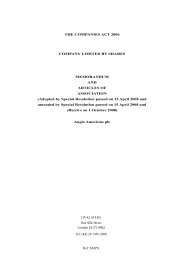


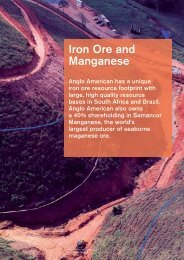
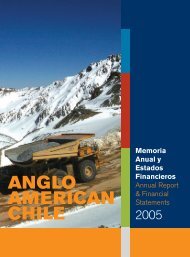
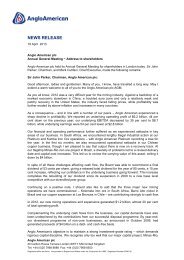
![English PDF [ 189KB ] - Anglo American](https://img.yumpu.com/50470814/1/184x260/english-pdf-189kb-anglo-american.jpg?quality=85)
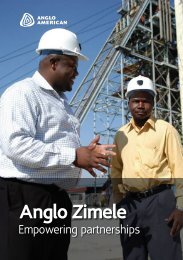

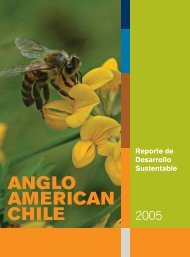

![pdf [ 595KB ] - Anglo American](https://img.yumpu.com/49420483/1/184x260/pdf-595kb-anglo-american.jpg?quality=85)
![pdf [ 1.1MB ] - Anglo American](https://img.yumpu.com/49057963/1/190x240/pdf-11mb-anglo-american.jpg?quality=85)
